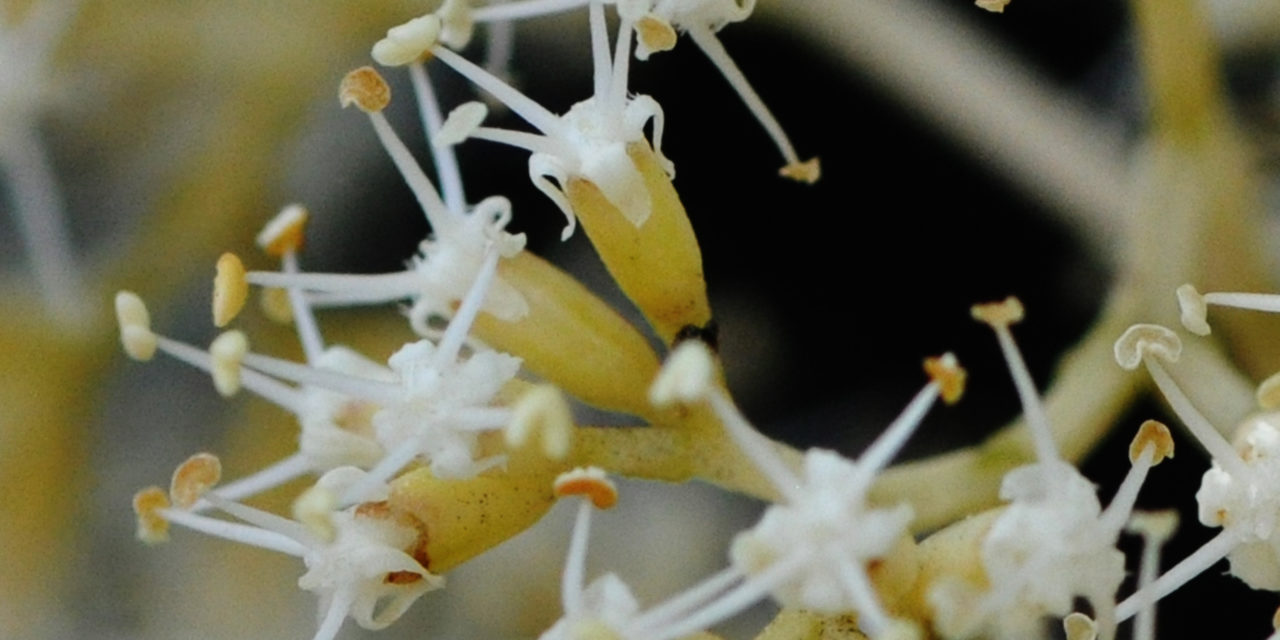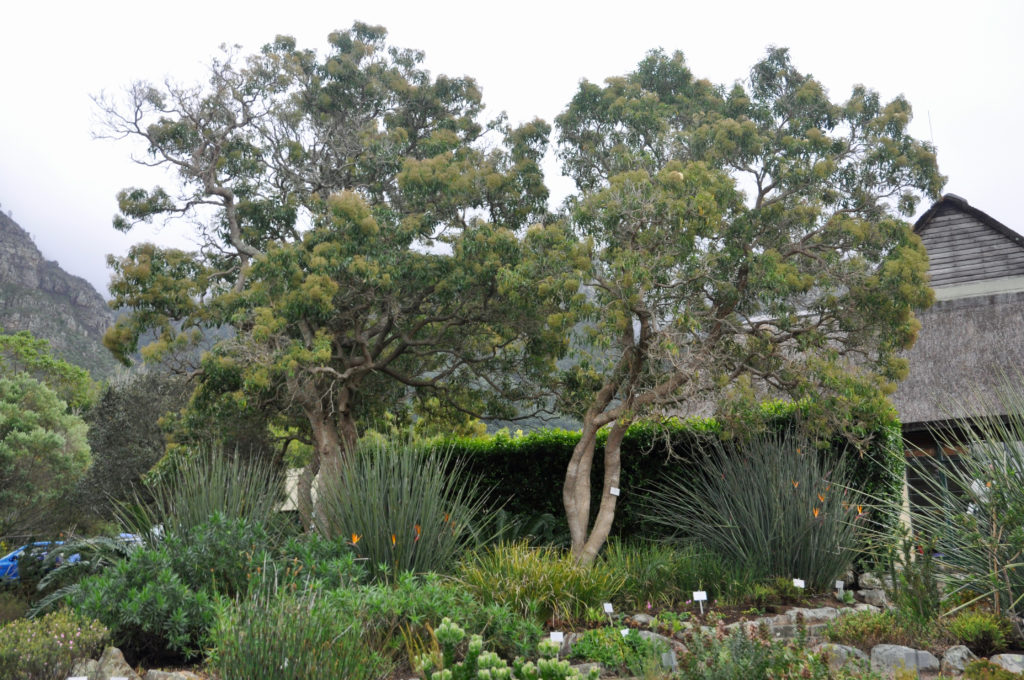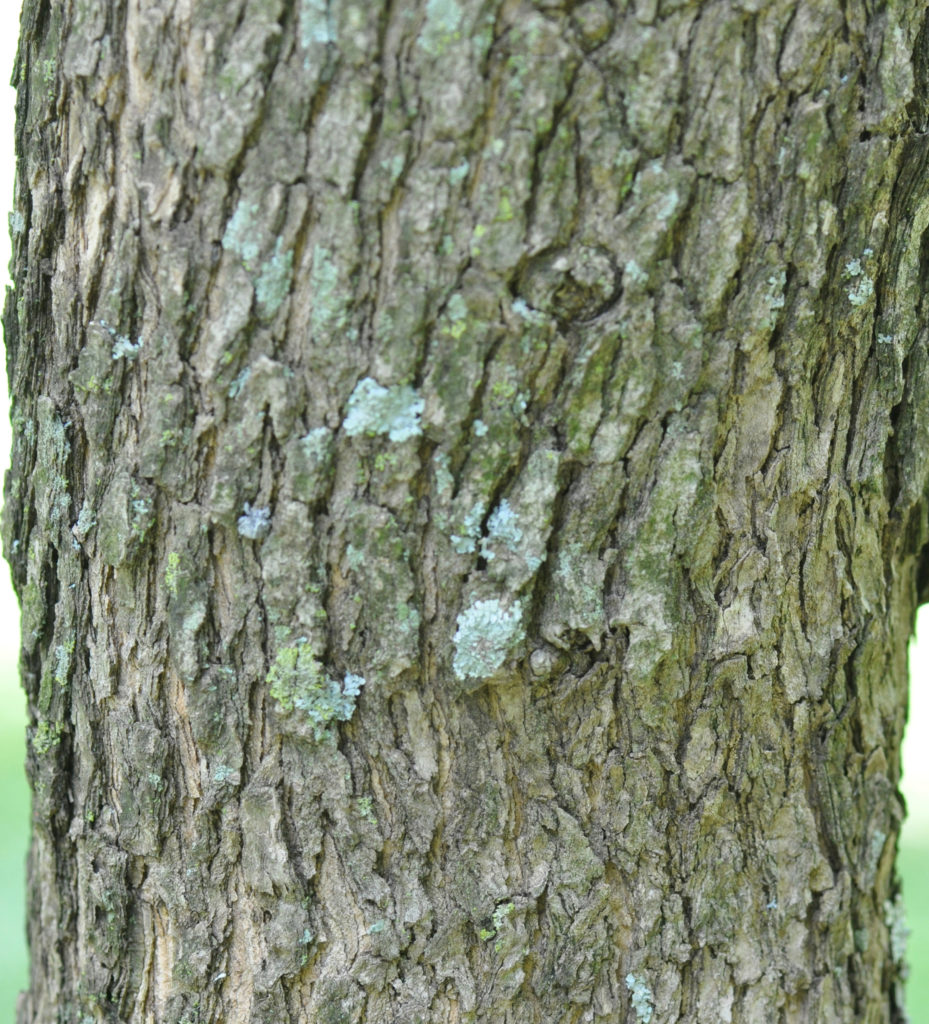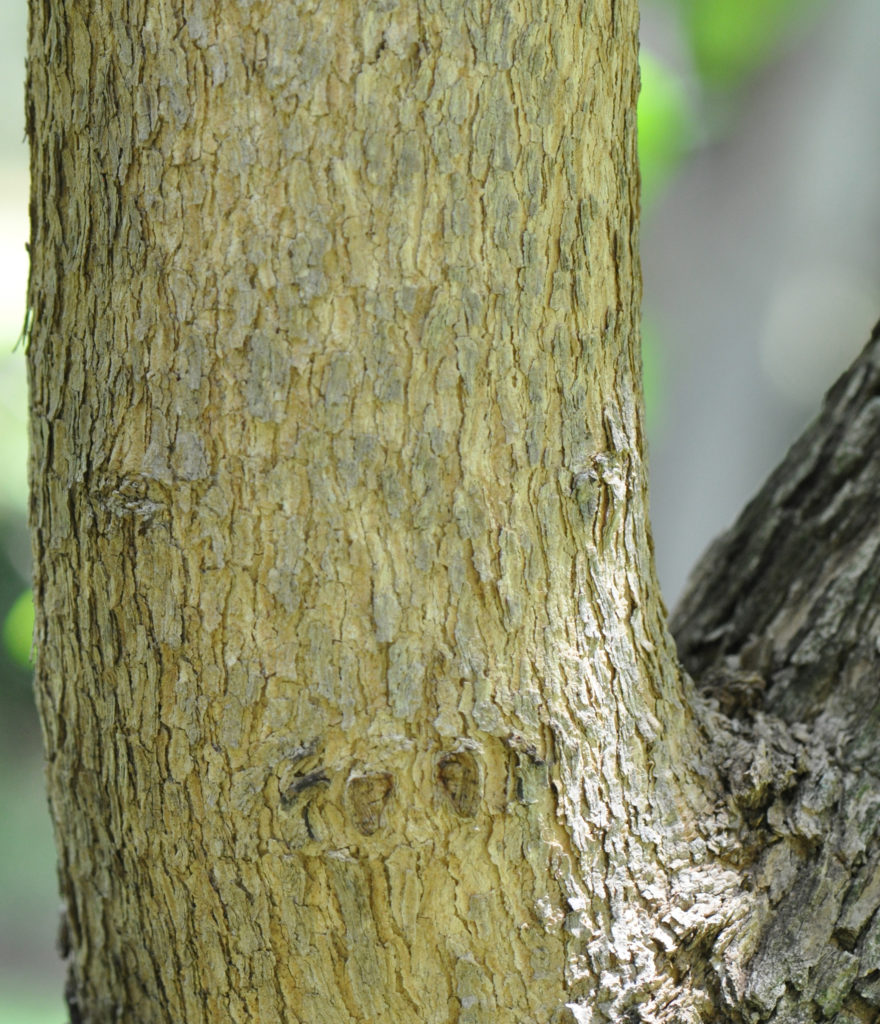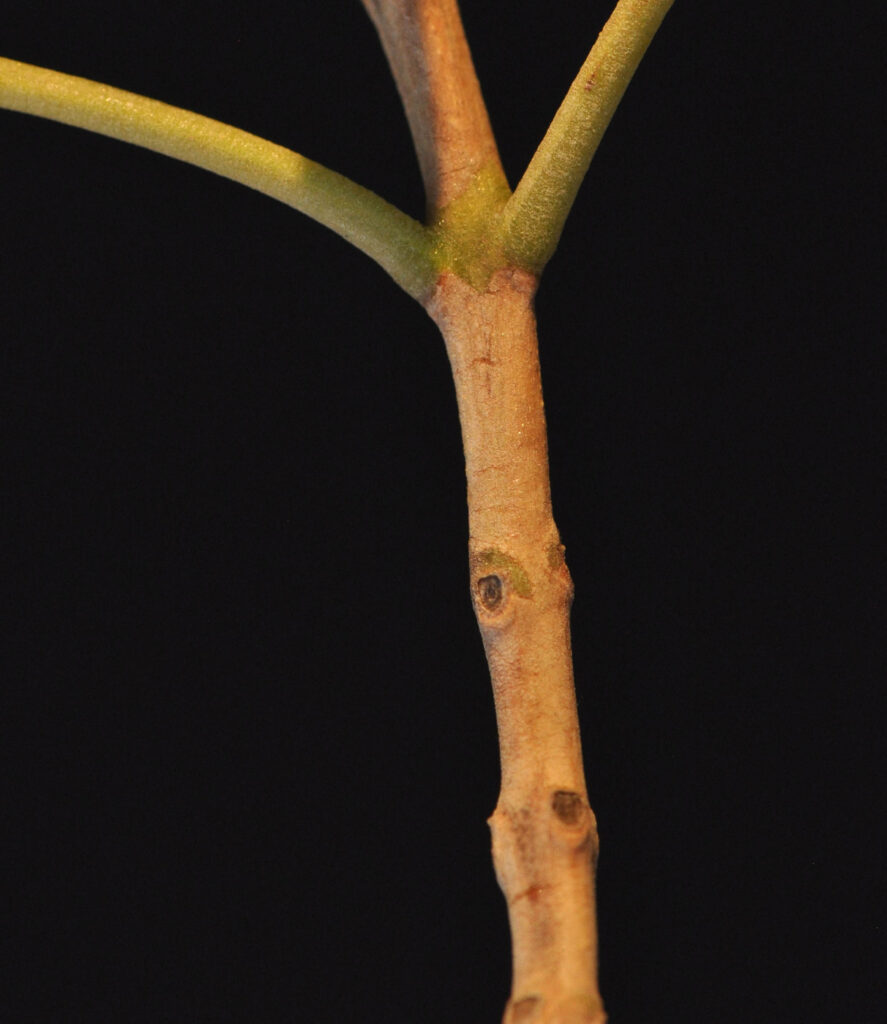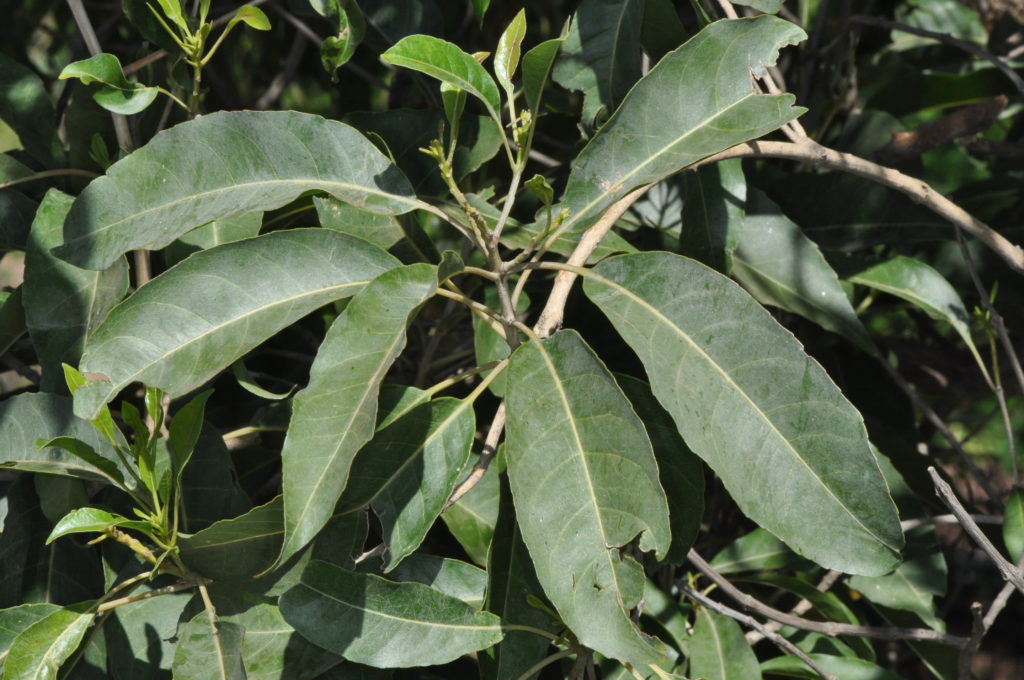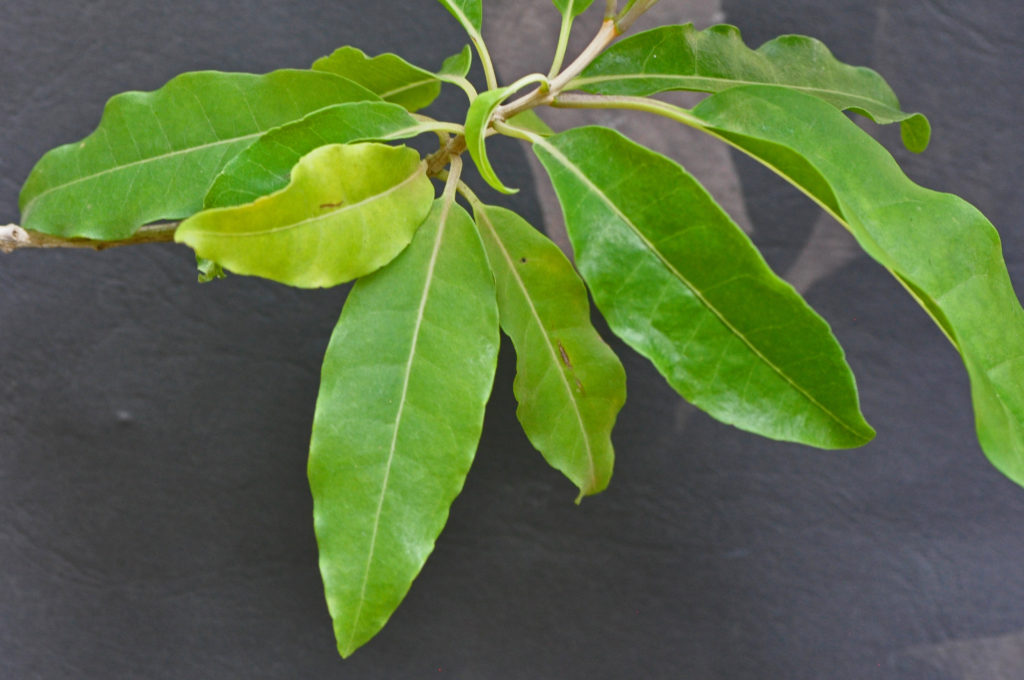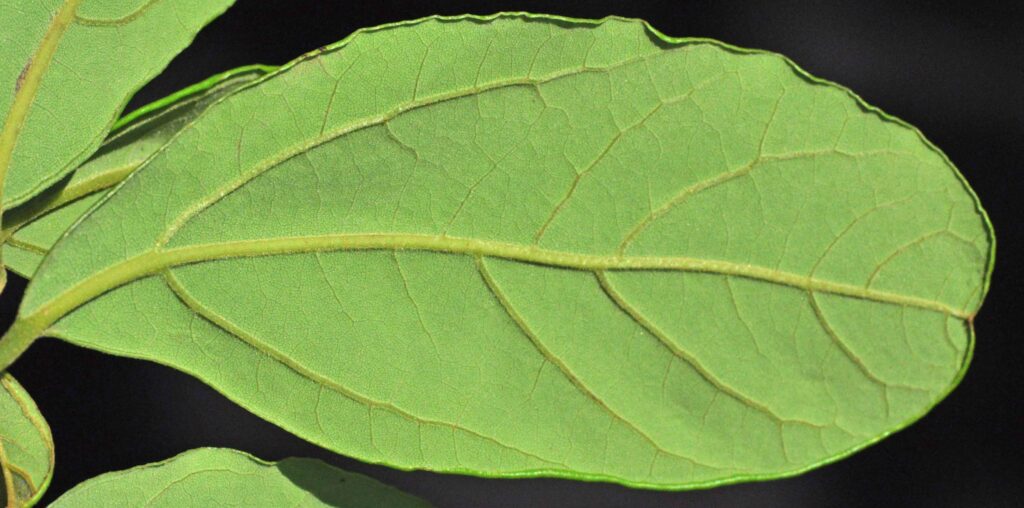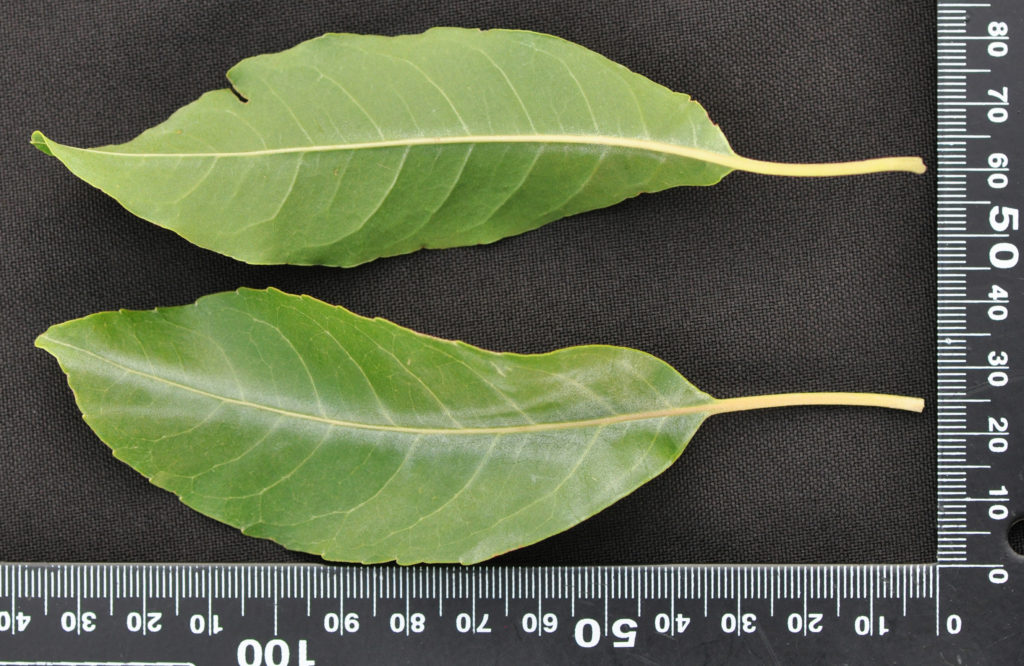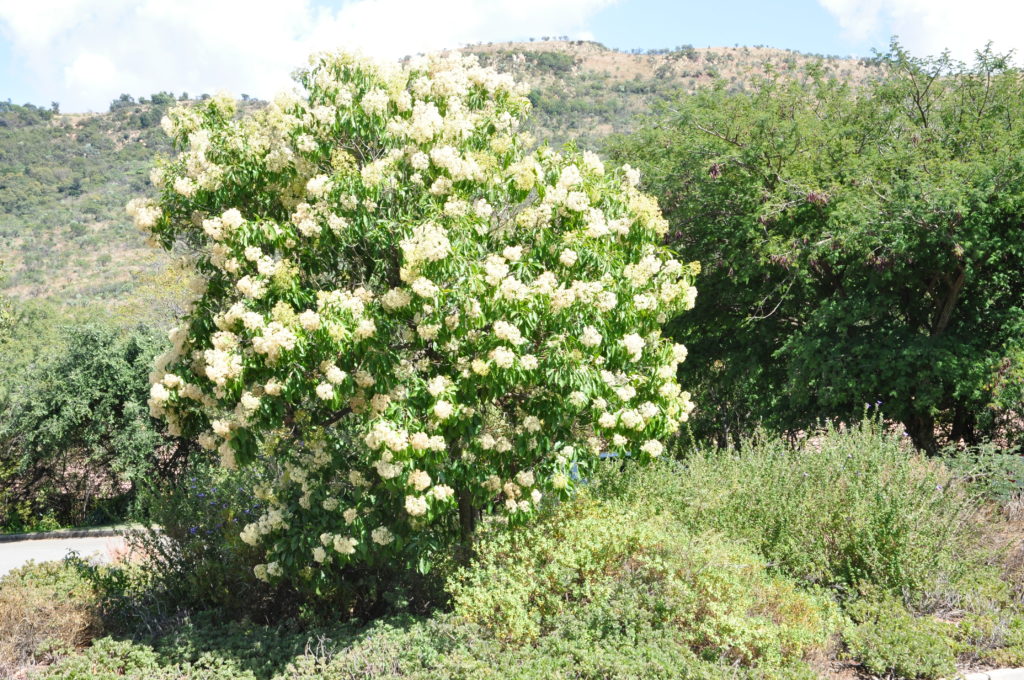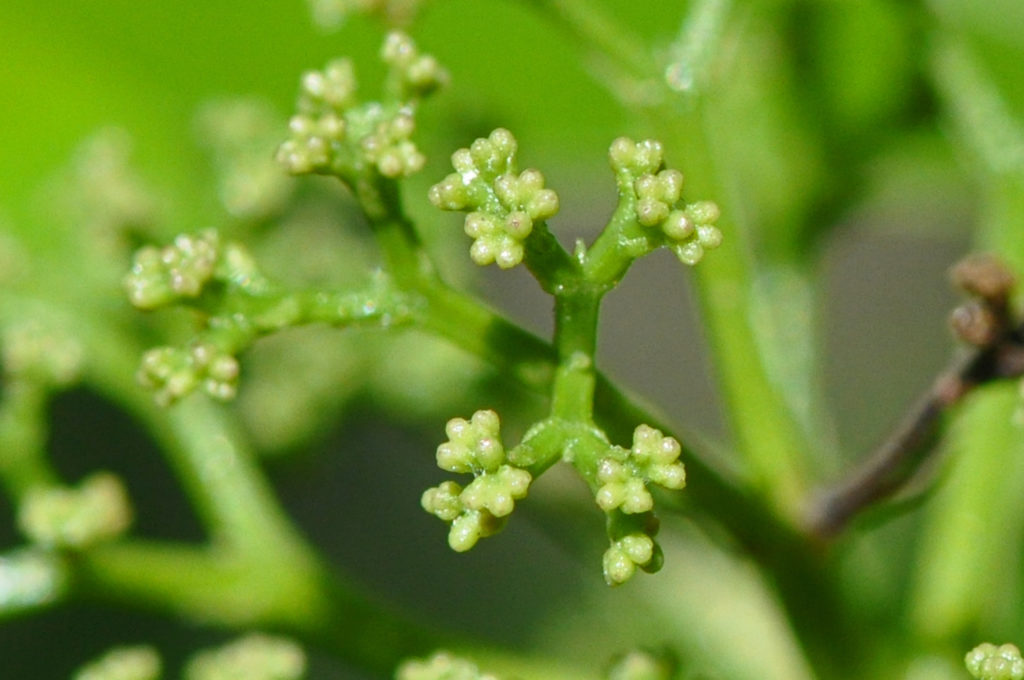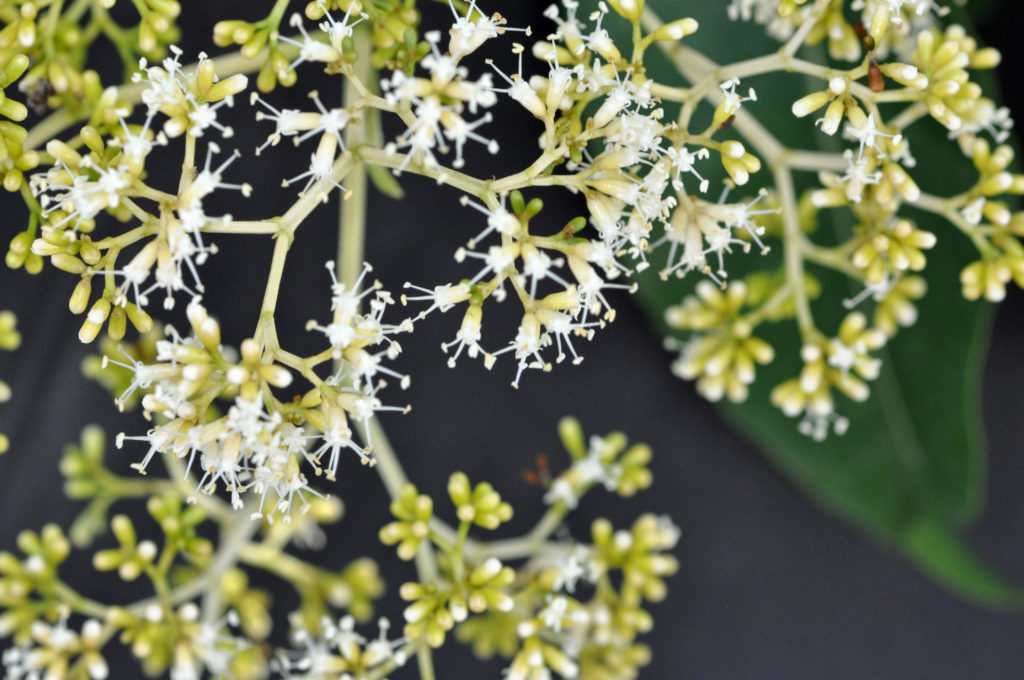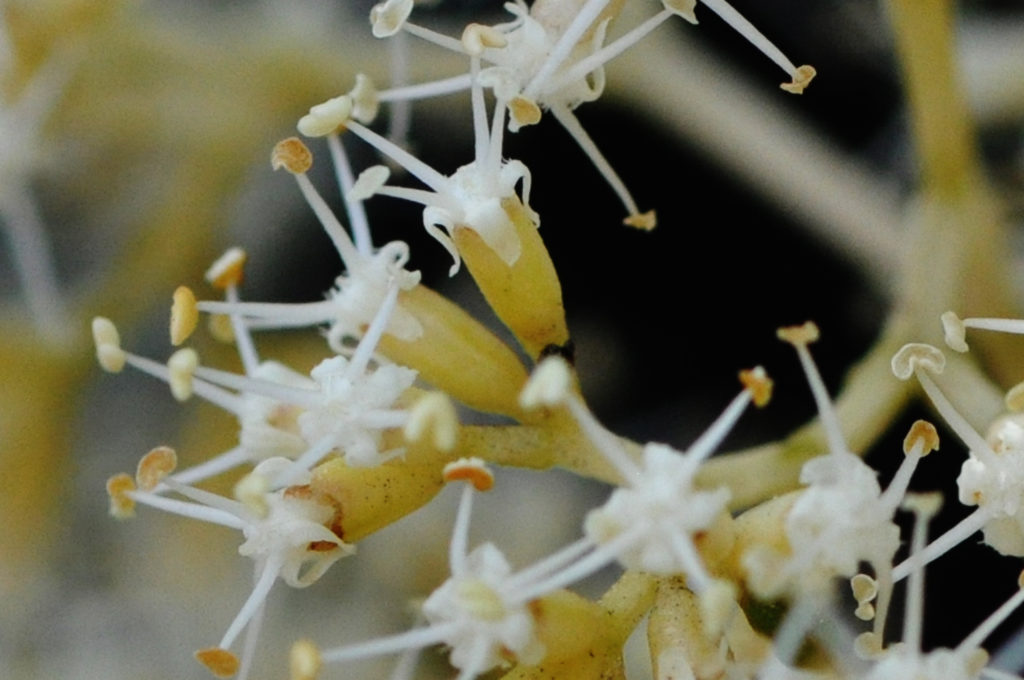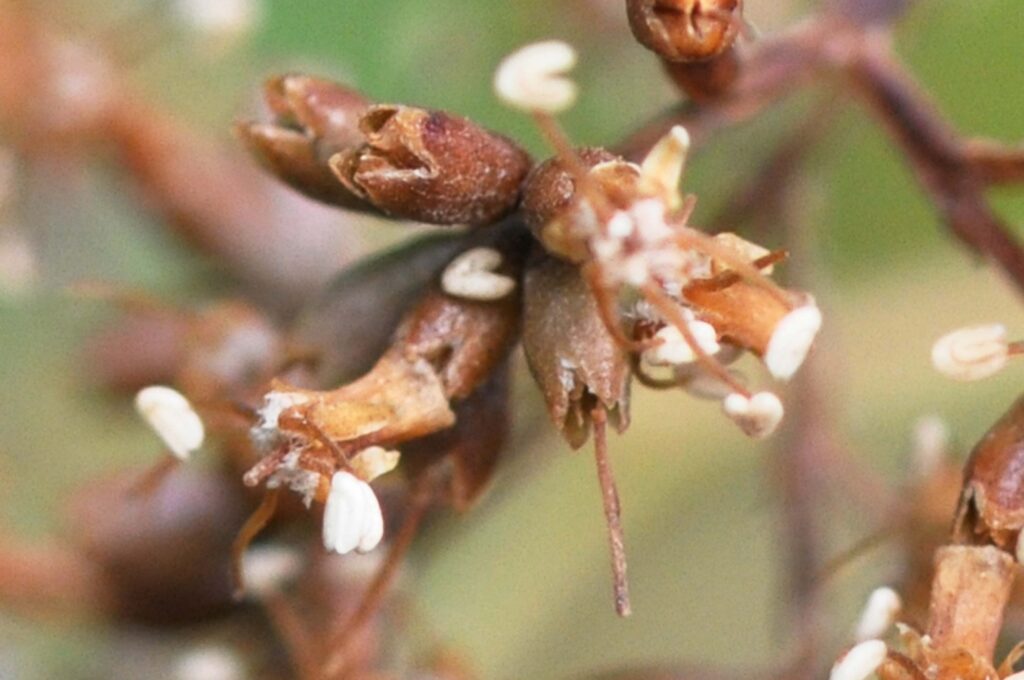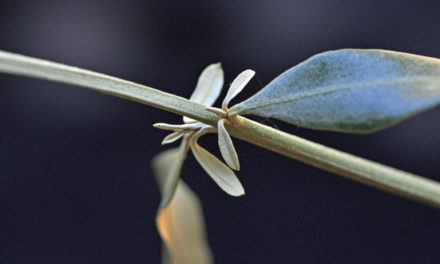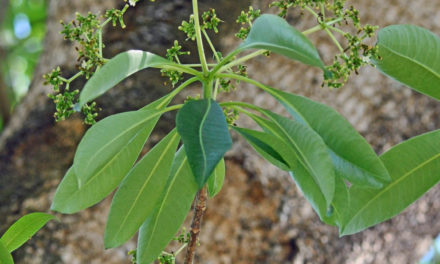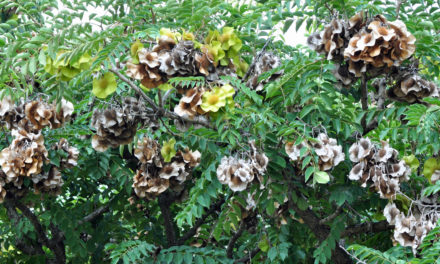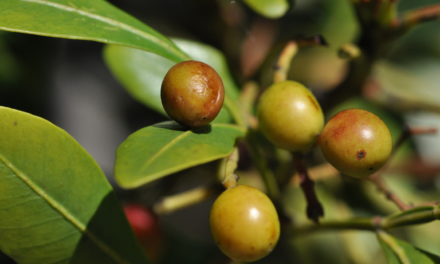General Info – summary remove
This thornless Tree with its rounded canopy is usually up to 10m high with non-aggressive roots. Greyish bark becomes rough. Simple, often broadly elliptic, initially light green and entire Leaves lack stipules. Many tiny bisexual regular 4-merous & impressive Flowers are late flowering & in panicles with widely extended stamens & a superior ovary. Fruit is a small, ovoid, brown capsule with tiny black seeds.
Description
Nuxia floribunda
Previous Names: Nuxia dentate, Nuxia schlechten, Lachnopylis floribunda.
SA Tree No. 634.
Common names: (Afr) Bosvlier, Vlier, Vlierboom, Vlierwortel, Wildevlier, Wildevlierboom. (Eng) Forest Elder, Forest Nuxia, Kite Tree, Vlier Root, White Elder, Wild Elder, Wild Peach. (isiXhosa) Ingqota, Isikali, Isikhali. (isiZulu) Ingobese, Ithambo, Umdlambandlaze, Umgqwagqu, Umgwaqu, Umhlambandlazi, Umkhobeza, Umlulama, Umsumuwembuzi. (Northern Sotho) Motlhabare. (siSwati) Sitsambo, Inkunzi. (Tshivenda) Mpupumwa, Mula-notshi.
Family: Stilbaceae: (Family with 6 genera and about 14 species). Local genera on this website include Anastrabe, Bowkeria, Halleria, and Nuxia. Members of this family have simple and entire Leaves that lack stipules and have recurved margins. Non-stellate hairs are present. Flowers are bisexual and zygomorphic or regular and the corolla is funnel-shaped and usually 2-lipped. The usually 4 Stamens are epipetalous, and the usually superior Ovary initially has 2 locules each with 1 ovule. Fruit is usually a dehiscent capsule but may be a berry.
Name derivation: Nuxia named after M. de la Nux a French botanist on Reunion Island. floribunda – flowering in profusion. There are 5 species of the genus Nuxia in the southern Africa.
Conservation: National Status: L C. Least Concern. Assessment: 2005 (W. Foden and L. Potter).
Tree
With its rounded canopy (photo 942), this mainly upright Tree is usually from 3-10m high but may reach 20m. The grey to brown Trunk is up to 60cm wide and may be twisted or crooked especially in smaller trees. The Crown may be large and rounded. Branching occurs fairly high up (photo 902). The young branches are an orange red colour (photo 970). They are initially marked with distinctly raised leaf scars (photo 970). Nodes (joint from where the leaves may arise) are finely hairy and slightly swollen. Finely hairy Twigs (young slender woody shoots growing from a branch or stem of a tree or shrub) are angular to squarish. The stringy, fibrous Bark is pale grey to grey-brown, initially smooth, becoming roughish and slightly fissured or fluted when older (photo 500 & 501). Long flaking strips may be visible.
- 902. 2018/09/15. Kirstenbosch NBG. Photo: David Becking.
- 500. 2014/10/28. Walter Sisulu NBG. Photo: David Becking.
- 501. 2014/10/28. Walter Sisulu NBG. Photo: David Becking.
- 970. 2018/03/07. Walter Sisulu NBG. Photo: David Becking.
Leaves
On this densely leafy evergreen tree, the usually hairless, soft, drooping often wavy (photo 701) fragrant and the light green Leaves are simple (have a single blade which may have incisions that are not deep enough to divide the leaf into leaflets). They often occur in whorls of 3 or are opposite and darker above (photos 162, 701 & 969). Leaves are variously shaped and oblong, oval, broadly elliptic, narrowly rounded or even lance shaped. They are more than 3 times as long as wide and up to 19 x 6cm – usually smaller (photo 969). Youngish leaves are a light glossy green above (photo 701) and even lighter below. The lightish leaves makes them distinguishable from the other darker leafed forest trees. The raised pale green Midrib is noticeable – especially on the lower surface (photo 969). It may be red or purplish in young leaves. The Apex is pointed and the Base tapers. Lateral veins are visible above and raised below (photo 622). The rolled under Margin (photo 622) is usually entire (with a continuous margin, not in any way indented). It may be slightly or obscurely serrated (photo 969) – especially on coppice growth (when stems are cut or burned it causes regrowth from the stump or roots). The thin Petiole (leaf stalk) is up to 4,5cm long and may be purplish in young leaves. (N.B. leaf length excludes the petiole). Stipules (basal appendage of the petiole) are absent.
- 162 2014/10/21 Walter Sisulu NBG. Photo: David Becking.
- 701. 2014/09/13. Lowveld NBG. Photo: David Becking. 2014/09/13 Lowveld NBG. Photo: David Becking.
- 622. 2017/10/24/ Walter Sisulu NBG. Photo: David Becking.
- 969. 2018/03/07. Walter Sisulu NBG. Photo: David Becking.
Flowers
The green buds (photo 742) may be sticky. The sweet smelling, very small creamy white Flowers are collectively most impressive (photo 802). They are located terminally or near the ends of branches in leaf axils. Large numbers of flowers develop in axillary or terminal Panicles (indeterminate, branched inflorescence with stalked flowers – photo 644) which are up to 30cm long. Individual flowers are less than 4mm x 2mm. Use of a hand lens is suggested for closer examination. Individual flowers are bisexual and actinomorphic (Regular, symmetrical. Flowers are vertically divisible into similar halves by more than 1 plane passing through the axis). The leathery Calyx has 4 Sepals that are erect, yellow, tubular and lined with hairs. The Corolla is joined at the base to form a tube and only the 4 white Petal lobes extend beyond the calyx. As they emerge, the lobes curl over and hang down the calyx with the apex bending slightly away (photo 641). The 4 Stamens arise between the corolla lobes, close to the throat of the corolla tube and are exserted (sticking out; projecting beyond). These stamens distinctively protrude outwards and away from the flower centre (photo 641). The free, straight Filaments have Anthers with V-shaped Thecae (pollen sacs – photo 484 under Fruit). There is a single Pistil (a unit of the Gynoecium, the female element of the flower, composed of the Ovary, Style and Stigma). The superior Ovary contains 2 fused Carpels (female reproductive structure that encloses the ovules). The Ovary, with many Ovules, narrows into a Style with a protruding Stigma that may appear later than the stamens (photo 484 under Fruit). The flower is possibly partly self and bee pollinated. (Mar-Oct). Flowers are similar to those in Schefflera umbelliferae.
- 802. 2015/04/21. Walter Sisulu NBG. Photo: David Becking.
- 742. 2014/12/30. Walter Sisulu NBG. Photo: David Becking.
- 644. 2015/04/14. Walter Sisulu NBG. Photo: David Becking.
- 641 2015/04/14 Walter Sisulu NBG. Photo: David Becking.
Fruit
The small – about 4mm long, ovoid, pale creamy brown and hairy Fruit is a Capsule (a dry fruit resulting from the maturing of a compound ovary with more than 1 carpel). The capsule protrudes slightly beyond the persistent Calyx. The woody capsule splits at the apex into 4 lobes (photo 484). Here the well-extended style is still visible. Many tiny, wind dispersed black seeds develop in each capsule. Old capsules persist on the tree. (Jun-Oct).
- 484. 2017/07/18. Walter Sisulu NBG. Photo: David Becking.
Distribution & Ecology
When flowering, the widespread, impressive flowers make this plant easier to identify (photo 802 – under Flowers). These Plants are located from the coast to mist belts, in the Western Cape (e.g., Knysna Forest), Eastern Cape (e.g., Baviaanskloof), KwaZulu-Natal and inland to Mpumalanga, Limpopo. They are also found in Mozambique (central east), Eswatini (Swaziland), the eastern highlands of Zimbabwe, Zambia and in Malawi. These plants are common in evergreen forests, forest margins and rocky outcrops up to about 1 500m. Nuxia floribunda is drought and cold sensitive therefore not found in cold, dry regions. Bees are largely responsible for pollination.
Ethnobotany
The Roots are non-aggressive. Wood is pale yellowish to white, hard, close grained, dense and generally useful to farmers and for making furniture. It was once used in the construction of wagons. Timber is used for fence posts and general carpentry. Bark is rich in tannin. Best flowering often occurs every second years. Game and livestock graze the Leaves. Propagation is from seeds or cuttings. This reasonably fast-growing plant is sensitive to heavy frost. Propagation is from seeds or cuttings. Young plants need water and are susceptible to Fungal attack. This is a good decorative and honey tree. Local medicine makes use of this tree.
References
Boon, R. 2010. Pooley’s Trees of eastern South Africa. Flora and Fauna Publications Trust, Durban.
Burrows, J.E., Burrows, S.M., Lotter, M.C. & Schmidt, E. 2018. Trees and Shrubs Mozambique. Publishing Print Matters (Pty) Ltd. Noordhoek, Cape Town.
Coates Palgrave, M. 2002. Keith Coates Palgrave Trees of Southern Africa, edn 3. Struik, Cape Town.
Foden, W. & Potter, L. 2005. Nuxia floribunda Benth. National Assessment: Red List of South African Plants version 2020.1. Accessed on 2023/09/16.
Lawrence, G. H. M, 1951. Taxonomy of Vascular Plants. The Macmillan Company, New York. Tenth Printing 1965.
Palmer, E. & Pitman, N. 1972. Trees of southern Africa, Balkema. Amsterdam, Cape Town.
Schmidt, S. Lotter, M. & McCleland, W. 2002. Trees and Shrubs of Mpumalanga and the Kruger National Park. Jacana, Johannesburg.
van Wyk, B. & van Wyk, P. 1997 Field guide to Trees of Southern Africa. Struik, Cape Town.
http://www.biodiversityexplorer.org/plants/stilbaceae/index.htm
https://en.wikipedia.org/wiki/Lamiales
http://plantzafrica.com/plantnop/nuxiaflor.htm
http://posa.sanbi.org/flora/browse.php?src=SP
http://www.theplantlist.org/1.1/browse/A/Stilbaceae/

